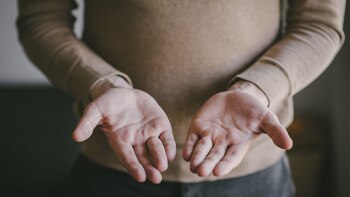
The risk of ending up in the hospital with COVID-19 may literally be in one's own hands. A new study published in the specialized journal Nature found that the length of the fingers shows a link with the levels of sex hormones in a person. Researchers at Swansea University, in the UK, found that a patient's testosterone levels play a key role in how they get sick after infection.
Previous studies show that having a longer ring finger is a sign of higher testosterone levels in the womb. On the other hand, a longer index finger indicates higher levels of estrogen. Generally, men have longer ring fingers and women have longer index fingers.
The new study examined this link between sex hormones before birth and during puberty and the rate of hospitalizations due to COVID. Their findings revealed that people with short “feminized” little fingers compared to their other digits end up suffering more severe cases of COVID-19. In addition, people who have larger differences in size between the fingers of the right and left hand are at even greater risk.
Although most people experience only mild symptoms of COVID-19, the elderly and men are more likely to have a serious case that requires urgent attention. This has led scientists to wonder whether a man's testosterone levels play a role in the severity of the disease. One theory is that high testosterone levels cause COVID to worsen. However, another study links low levels in older men to a severe case of the virus.

To find out which one is correct, the team examined the size ratios of digits 2, 3, 4 and 5 in the hands of more than 150 people. Fifty-four of these individuals were COVID-19 patients, while the others served as a healthy control group. Specifically, the results show that the larger differences between the 2D:4D and 3D:5D ratios in each person's hands had a connection to a more severe case of COVID-19.
“Our findings suggest that the severity of COVID-19 is related to low testosterone levels and possibly high estrogen levels in both men and women,” said Professor John Manning, one of the study's authors and specialist in applied sports, technology, exercise and medicine from Swansea University in the United Kingdom.
Feminized differences in inpatient digit ratios support the view that people who have experienced low testosterone and/or high estrogen levels are prone to severe COVID-19 expression. “This may explain why the most at-risk group is older men,” the researcher continues. This is significant because if it is possible to more accurately identify who is most likely to have severe COVID-19, it would help guide vaccination processes. Right-to-left differences in digit ratios (particularly 2D:4D and 3D:5D) can help in this regard.”

Currently, the study authors noted that there are several trials that examine anti-androgen drugs (testosterone) that can help treat COVID-19. At the same time, they are also considering testosterone as a possible antiviral drug against COVID. “Our research is helping to increase understanding of COVID-19 and may bring us closer to improving the repertoire of antiviral drugs, which helps to shorten hospital stays and reduce mortality rates,” adds Professor Manning. The sample is small but ongoing work has increased the participation of other individuals. We hope to report more results shortly.”
This is not the first study to relate finger length to apparently unrelated topics. Previous research established a certain relationship between the length of children's fingers with the hospitalizations of their respective mothers, as well as with vulnerability to childhood diseases.
KEEP READING:
Últimas Noticias
Debanhi Escobar: they secured the motel where she was found lifeless in a cistern
Members of the Specialized Prosecutor's Office in Nuevo León secured the Nueva Castilla Motel as part of the investigations into the case

The oldest person in the world died at the age of 119
Kane Tanaka lived in Japan. She was born six months earlier than George Orwell, the same year that the Wright brothers first flew, and Marie Curie became the first woman to win a Nobel Prize

Macabre find in CDMX: they left a body bagged and tied in a taxi
The body was left in the back seats of the car. It was covered with black bags and tied with industrial tape
The eagles of America will face Manchester City in a duel of legends. Here are the details
The top Mexican football champion will play a match with Pep Guardiola's squad in the Lone Star Cup

Why is it good to bring dogs out to know the world when they are puppies
A so-called protection against the spread of diseases threatens the integral development of dogs



